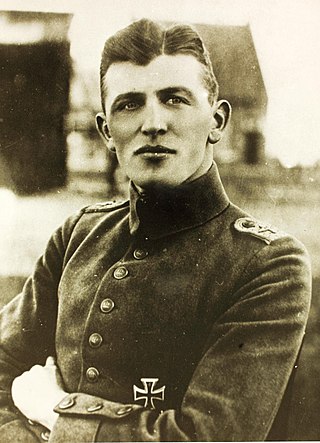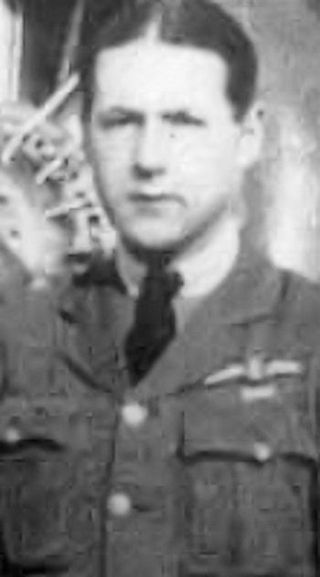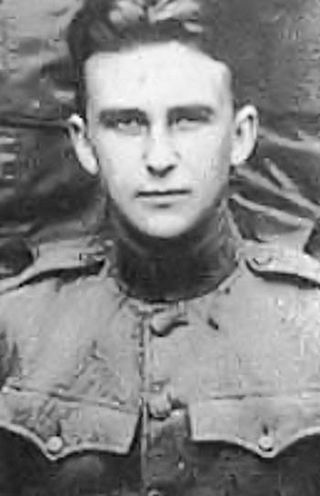Frank Ormond "Mongoose" Soden DFC & Bar was a First World War flying ace and RAF commander during the Second World War.

Arthur Raymond Brooks was an American World War I flying ace of the United States Army Air Service credited with shooting down multiple enemy aircraft. Among his most prominent achievements was when he single-handedly took on a squadron of German-flown Fokker planes officially downing 2 of them in one aerial battle piloting his SPAD XIII named Smith IV. He was a pioneer in the development of radio navigational aids (NAVAIDs) used by pilots for location and navigation as well as air-to-ground communications. Brooks also participated in early endeavors to commercialize aviation as a passenger-carrying business and was one of the earliest commercial pilots involved with carrying mail for the US Post Office Department.

OberleutnantHenrich Claudius Kroll Pour le Merite, Knight's Cross of the Royal House Order of Hohenzollern, Saxony's Albert Order Knight Second Class with Swords, Iron Cross First and Second Class, was a World War I fighter ace credited with 33 victories.
Captain Samuel Frederick Henry "Siffy" Thompson was a British World War I two-seater fighter ace who, in conjunction with his observer-gunners, was credited with thirty aerial victories before being shot down and killed. Despite having an active fighter career of only five months, he reached the rank of captain and won two British military decorations.
Major Thomas Sinclair Harrison was a World War I fighter ace credited with 22 aerial victories. He was a balloon buster, as he destroyed two enemy observation balloons. This made him the fourth highest scoring South African.
Captain William Otway Boger was a Canadian World War I flying ace credited with five aerial victories.
Lieutenant Philip Terence Holligan was a British World War I flying ace credited with six aerial victories.

Captain Frank Lucien Hale was a World War I flying ace credited with seven aerial victories. He later accompanied Charles Lindbergh in a transcontinental flight.

Thomas Charles Richmond Baker, was an Australian soldier, aviator, and flying ace of the First World War. Born in Smithfield, South Australia, he was an active sportsman in his youth and developed a keen interest in aviation. He was employed as a clerk with the Bank of New South Wales, before he enlisted in the Australian Imperial Force in July 1915, for service in World War I. Posted to an artillery unit on the Western Front, he was awarded the Military Medal for carrying out numerous repairs on a communications line while subject to severe artillery fire. In June 1917, Baker was awarded a bar to his decoration for his part in quelling a fire in one of the artillery gun pits that was endangering approximately 300 rounds of shrapnel and high explosive.
Captain George Everard Gibbons was a British World War I flying ace credited with 18 aerial victories gained while flying a Bristol F.2 Fighter in 1918. Both of his observers, Sidney Knights and Thomas Elliott, also became aces flying with him. Gibbons' final tally consisted of three enemy aircraft destroyed by fire, five others destroyed, and ten driven down out of control.
Captain Walter Alexander Tyrrell was a British First World War flying ace credited with seventeen aerial victories.

Lieutenant Kenneth Russell Unger was an American World War I flying ace credited with fourteen aerial victories. His candidacy rejected by his own nation, Unger applied to the British Royal Flying Corps for military pilot training in June 1917. Once trained, he was assigned to the Royal Naval Air Service (RNAS). As the RNAS was merged into the Royal Air Force, Unger scored his aerial victories between 26 June and 1 November 1918. In later life, Unger remained involved in aviation and served again during World War II. He also joined the U.S. Navy Reserves, rising to the rank of rear admiral.
Captain Reginald Carey Brenton Brading was a British World War I flying ace credited with thirteen confirmed aerial victories.
Captain John Ellis Langford Hunter was a British World War I flying ace credited with 13 confirmed aerial victories.

Lieutenant Howard Burdick DSC DFC was an American World War I flying ace credited with eight confirmed aerial victories. He and his son, Clinton D. Burdick, are the only known pair of father-son flying aces.
Second Lieutenant Francis James Ralph was a British World War I ace credited with 13 confirmed aerial victories over German fighter aircraft while flying as an aerial observer.
Lieutenant William Thomas Barnes was an English World War I flying ace. He served as an observer/gunner in Bristol F.2 Fighters, gaining, in conjunction with his pilots, nine confirmed aerial victories over German Fokker D.VII fighter planes. Post-war he served in the Royal Irish Constabulary and was killed in the Kilmichael ambush on 28 November 1920.
Captain Roy Manzer, was a Canadian World War I flying ace credited with 12 official aerial victories. After his aerial military service, he returned to Canada and a long and distinguished legal and civic career.
Merrill Samuel Taylor was a Canadian flying ace of the First World War. He was credited with seven aerial victories while flying a Sopwith Camel fighter for the Royal Naval Air Service and, later, the Royal Air Force. He touched off the air battle that resulted in the death of the war's leading ace, Manfred von Richthofen, on 21 April 1918. On 2 May 1918, he killed German ace Hans Weiss for his fifth victory. Taylor was killed in action by Franz Büchner on 7 July 1918.
Second Lieutenant Bruce Digby-Worsley was a World War I British flying ace credited with 16 aerial victories between June and September 1918.




